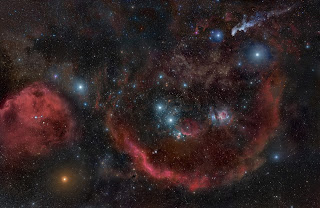Welcome, stargazers! At FreeAstroScience.com, we're passionate about making the wonders of the cosmos accessible to everyone. Today, we're diving into one of the most recognizable constellations in our night sky - Orion. Whether you're a seasoned astronomer or just starting your celestial journey, we promise you'll discover something amazing about this celestial hunter that's been watching over humanity for millennia.
The Celestial Hunter's Portrait
Orion is truly the superstar of the winter sky, dominating our view from November to February. This cosmic giant spans 594 square degrees, making it the 26th largest constellation. What makes it so special? Picture this: seven brilliant stars forming an unmistakable hourglass shape, with the famous three-star belt at its center.
Ancient Tales Written in Stars
The story of Orion is a wild ride through ancient mythology. As the son of Poseidon, this legendary hunter was quite the character - think ancient Greek superhero meets cosmic celebrity. His tale is packed with drama, including:
The Love Story Gone Wrong Our cosmic hero fell for Merope, a king's daughter, but her father wasn't having it. In a twist worthy of a Netflix series, the king had Orion blinded.
The Divine Drama Artemis, the hunting goddess, had a complicated relationship with Orion. Some say she killed him out of jealousy, while others blame a scorpion sent by Mother Earth herself.
Scientific Marvels
Recent Discoveries
The James Webb Space Telescope just dropped some mind-blowing news: it found pairs of planet-like objects in the Orion Nebula, dubbed "JuMBOs". These mysterious objects, weighing between 0.6 to 13 times Jupiter's mass, are challenging everything we thought we knew about planetary formation.
Stellar Highlights
The Belt and Beyond Orion's Belt isn't just a cosmic fashion statement - it's made up of three spectacular stars: Alnitak, Alnilam, and Mintaka. Below the belt, you'll find Orion's Sword, home to the spectacular Orion Nebula.
Brightest Stars
- Rigel: The constellation's brightest star, shining at magnitude 0.1
- Betelgeuse: A red supergiant that's the 11th brightest star in our sky
When and Where to Find Orion
Want to spot this celestial celebrity? January is your best bet, when Orion struts across the night sky around 9 PM[9]. You can catch this cosmic show from almost anywhere on Earth - it's visible between latitudes +85° and -75°.
Conclusion
From ancient myths to cutting-edge discoveries, Orion continues to surprise and inspire us. As we at FreeAstroScience.com always say, the universe's greatest stories are written in the stars - we just need to learn how to read them. Next time you look up at the night sky, remember you're not just seeing stars; you're witnessing a cosmic legacy that spans millennia. Keep exploring, keep wondering, and keep looking up!


Post a Comment